Multiple choice questions are fundamental survey questions which provides respondents with multiple answer options. Primarily, multiple choice questions can have single select or multi select answer options. These are the most fundamental questions of a survey or questionnaire where the respondents are expected to select one or more than one option from the multiple answer options.
Whenever we think of conducting surveys, we think of two things: kind of questions to ask and data collected from the answers to those questions. Essentially, the most important aspect of surveys is to formulate relevant questions that will help us extract clean data.
There are various types of survey questions that a survey creator can ask to evoke necessary responses from the person undertaking the survey. Out of these variations, the close ended questions are the most used in surveys.
Keep the following factors in mind while designing Multiple Choice Questions-
- Have a fair idea of the concepts that you would want to cover in the question and avoid composing questions that have hazy attributes.
- Form questions that evaluate respondents at conscious and subconscious levels like some factual questions, situational questions or analysis based questions.
A multiple choice question comprises of a stem, the correct answer/s and the distractors.
- A stem, that’s the question i.e. a problem or an incomplete statement - Make sure that you create a crisp, grammatically error-free and simple stem which has relevant information.
- The correct answer - This should be relevant to the stem and shouldn't consist of too many qualifiers like "always" and "some”. Use phrases as options when the stem is an incomplete statement.
- The other incorrect responses which are called ‘distractors’ - Ideally, create 4 distractors and should be in line with the correct answer. These distractors should usually be common misconceptions that your target audience may have.
The primary bifurcation of these questions is based on the number of answer options the respondents can select while responding the survey. So, single choice questions and multiple choice (multiple answer) questions are the two available main question types.
Single select Multiple Choice Questions
Single select questions are the questions where a respondent is asked to pick only one answer, from a predetermined set of responses of at least two or more options. They are one of the most common question types and are effective in determining a user’s primary preference, among a set of choices. They are closed ended questions that help the responded to choose from the options they initially might not have thought. They are extremely easy to respond and are an easily answered on handheld devices like mobile phone, Ipads, tablets and similar.
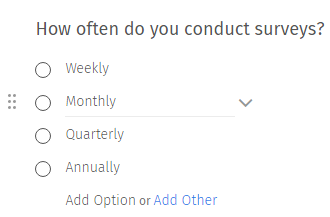
Multi select Multiple Choice Questions
Multi select multiple choice questions are similar to Multiple Choice questions. However, there is a slight difference in this question type, that these type of questions can have more than one correct answer. As a survey creator, you can create as many choices as necessary. In Multi select questions, the selections are permuted each time they appear. In non-permuting multiple selection questions, however, the selection order is static.Check boxes are used for such question types and the respondent needs to select the most appropriate answers from the given choices.
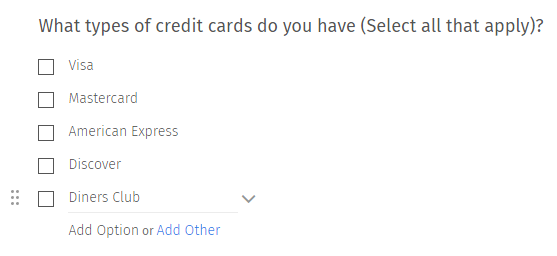
Drop Down Menu Multiple Choice Questions
By default, Multiple Choice questions in surveys offer a radio button that participants can use to make a selection. However, in this question type the answers appear in a drop down list. When you click on the drop arrow it shows multiple answer options from which the participant can choose the most appropriate answer option that responds to the particular question that is being asked. Drop down questions are easy to analyze as they allow to select only one answer option from the existing multiple options.
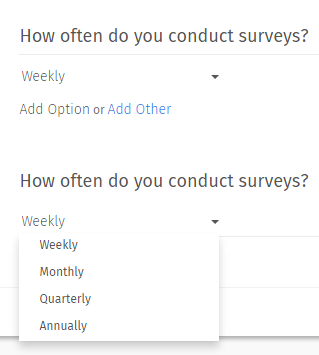
Star Rating Multiple Choice Question
This question type allows the respondent to rate a question or rank items using stars. More stars indicate a higher rating and vice versa. You get an aggregate response by the sum of stars for each choice. These questions are a good option when you want to gather information from the respondents if they like the product or service or not. These question types are used in various surveys and are extremely easy to respond to as the respondents just have to click on the stars to answer the question.

Text Slider Multiple Choice Question
Everyone loves slider! Not only the eating one ofcourse. The text slider questions are a good alternative to open ended questions, as they help the respondents gain some clarity of the questions asked, as the answers are already available to the question and the respondents only have to use the slide option to point the most appropriate answer. This question type can be used in most surveys and one of the best aspects of the slider question type is that the respondents can use the neutral option and can have no opinion at all.

Push to Social Multiple Choice Question
The Push To Social multiple choice questions allows you to send positive feedback on a survey to social networking sites like Facebook, Twitter, Google+ and Yelp. This question type can help you with branding and marketing of your business. If in case you receive a negative feedback you can always collect comments for the kind of feedback and make sure you take necessary actions immediately.

Numeric Slider Multiple Choice Question
In numeric slider multiple choice question the respondent can slide and answer the question by actually giving it a score between 0 to 100. In other words the preferences will be numeric values. Lesser the value the more unsatisfied is the customer and vice versa.

Thumbs Up/Down Multiple Choice Question
Ask a binary rating question and use the thumbs up or thumbs down option to understand the respondents opinion. This option essentially includes an image used for thumbs up or thumbs down that helps define the rating option. It helps the respondents to make a quick choice between like and dislike. However, it is advisable that the survey creator inserts a text box for additional comment if the respondents don’t want to choose for either of the available answer options.
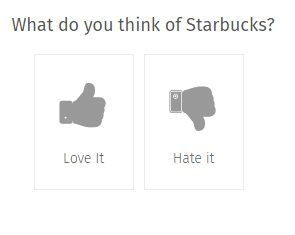
Smiley Rating Multiple Choice Question
The Star Rating question lets respondents evaluate a statement on a visual scale of stars. A weight is assigned to each icon in the scale, so a weighted average is calculated in the Analyze Results section.Usually in the star rating question the scale is set to 5 stars, but a survey creator can add more number of stars to the scale.

Multi Point Scale Matrix Table Multiple Choice Questions
Multi point matric table questions allow you to ask about multiple items in one single question. A Rating Scale question, commonly known as a Likert Scale, is a variation of the Matrix question where you can assign weights to each answer choice. This question can be used when we need to group questions that have the same answer option scale.
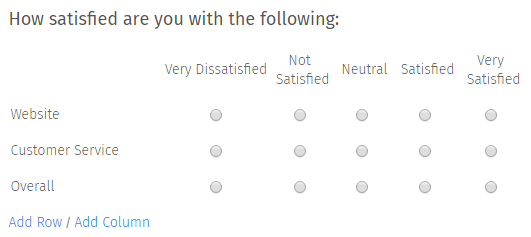
Matrix Table Multiple Choice Question with Check Boxes
A multi point scale question is a collection of various individual questions put together. In this way a survey creator can save a lot of time and space because the purpose of various individual questions are served in one question itself.In multiselect matrix, checkboxes are used enabling the user to select multiple options.
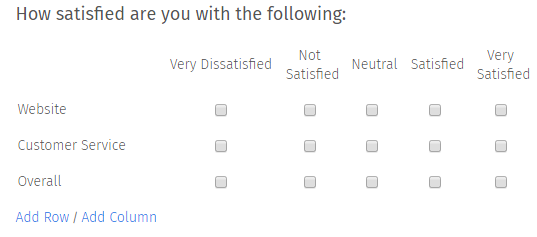
Spreadsheet based Multiple Choice Questions:
Spreadsheet based multiple choice questions allows the respondents to fill in text about the answer choice they have made. These question types usually have the choices where the respondent can like extremely or dislike extremely and also write why they have liked or disliked the particular option and give suggestions too.
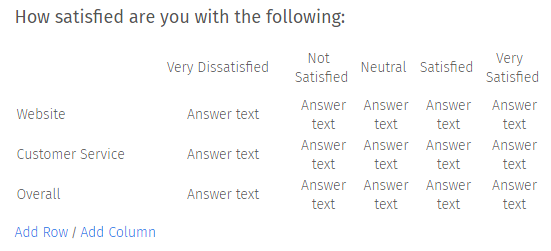
Side-By-Side Matrix Table Multiple Choice Question
The Side by Side matrix table multiple choice question allows you to ask many questions in one condensed table.Each column within a side by side question is treated as a separate question, possessing its own structure, format, and choices. Each row is an item for which respondents will answer the side by side questions.

Rank Order Multiple Choice Question
The Rank Order question type provides respondents the unique opportunity to rank a set of items against each other. Rank order scaling based multiple choice questions allow a certain set of brands or products to be ranked based on a specific attribute or characteristic. The ranking is essentially numerical a drop down box can be created. By asking this question the survey creator can understand the order of preference of the respondent and conclude their choice preference.
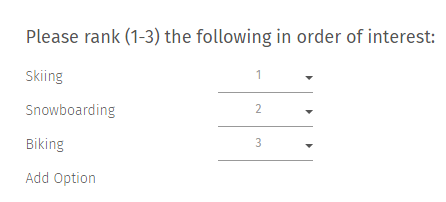
Constant Sum Multiple Choice Question
Constant Sum multiple choice questions provide respondents a way to enter numeric data. A Constant Sum question allows respondents to enter numerical values for a set of variables, but requires the values to add up to a pre-specified total.Each numeric entry is summed and can be displayed to the respondent.This is a great question type to use when asking financial, budget related questions or percentage based questions.

Drag and Drop Multiple Choice Question
Respondents in this type of survey question can drag and drop the answer choices to re-order them as they choose. This question type gives complete freedom to the respondent to order the answer options to best suit to their preference. This drag and drop option questions is interactive and will help the respondents choose wisely.
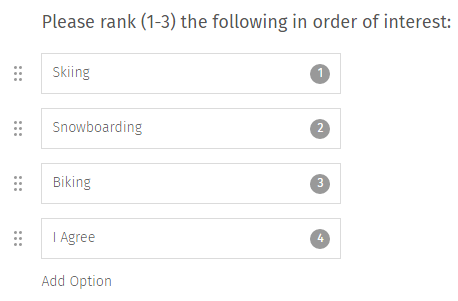
Single Select Image based Multiple Choice Question
This is a multiple choice single select question which has images next to the answer options. Radio buttons are used for single select type questions. The respondent has to choose one option from the existing image options. They're visual, making it easier and faster for your visitors to process the question. They look great and prevent your form from looking/feeling like a generic web form.
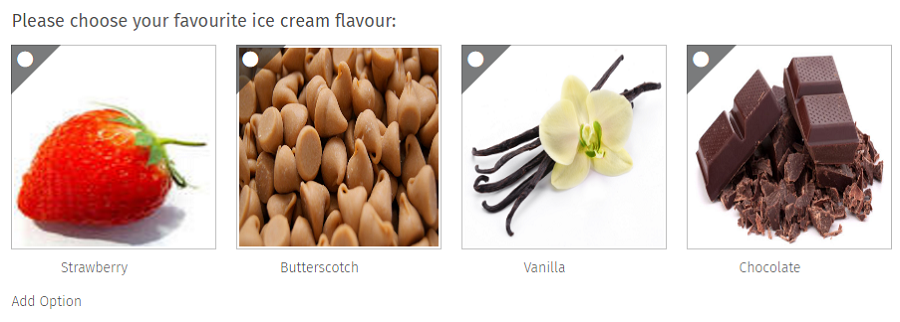
Multi Select Image based Multiple Choice Question
The multi select image select multiple choice question type Image displays multiple images to the respondent allowing them to select their answer by clicking directly on the images. Respondents are able to select multiple images that are already uploaded by the survey creator. Multi select image based questions are easy to report and the data can be collected and represented in a graphical manner.
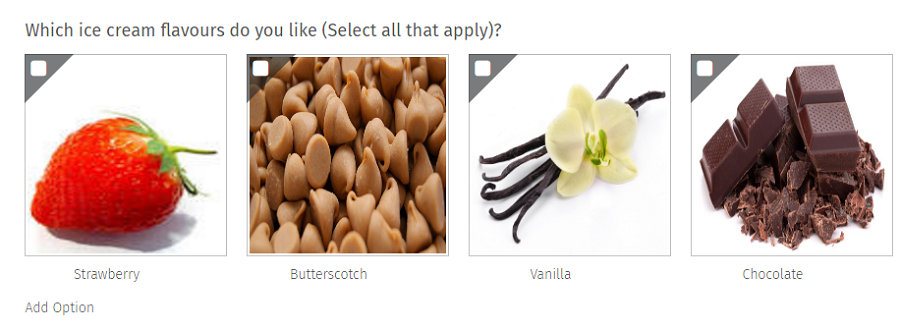
Image Rating Multiple Choice Question
Image rating multiple choice questions are a great way to start the survey as it makes the survey look attractive and helps the respondent make distinctive choices. This question type can be used in almost all types of surveys and helps the respondents invariably. You can start with uploading relevant images and frame your questions accordingly.

Multiple choice questions are those question types that can create a big impact on your research by allowing you to measure the customers’ opinions and their preference merely at a glance. Multiple choice questions are an amazing choice for the following:
-
Questions that are asked to know what stands out most with the users or customers.
-
Gauging preference for specific designs or elements of your product.
-
When you need to ask a certain question to evaluate the content.
Here are the 3 amazing tips to writing multiple choice questions:
-
Don’t forget to include “other” option: While writing the multiple choice questions it is advisable to include the “other” option so that the respondents have a say to express their opinion if they don’t like the particular answer options that have been given by the survey creator.
-
Provide clear answer options: It’s important to put distinctive clear answer options to the question that is being asked. If all the answers bleed together and there is no clarity then the respondents will be confused and not be able to choose the most appropriate answers from the options.
-
Avoid asking yes/no questions: If simply direct questions are asked then respondents will have little options to answer the questions, always give answer options that give respondents ample choices to choose from.
- They are less complicated and less time consuming
Imagine the pain a respondent goes through while having to type in answers when they can simply answer the questions at the click of a button. Here is where multiple choice lessens the complications.
Many-a-times the survey creator would want to ask straightforward questions to the respondent, the best practice is to provide the choices instead of them coming up with answers, this in-turn saves their valuable time.
- Responses get a specific structure and are easy to analyze
Surveys are often developed with respondents in mind, how will they answer the questions? This is where multiple choice gives a specific structure to responses, therefore becomes the best choice.
Let’s say at your workplace you receive a survey asking about the best restaurant, to host the Christmas party. Honestly speaking giving specific options isn’t going to hurt, rather, as a surveyor, you are sure that the answer will be from one of the options given to the respondents.
It will be easier for the surveyor to analyze the data as it will be free from any errors (as respondents won’t be typing in answers) and the surveyor would atleast know that not a random restaurant would be chosen.
- Helps respondent comprehend how they should answer
One of the positives of multiple choice options is that they help respondents understand how they should answer. In this manner, the surveyor can choose how generalist or specific the responses need to be.
At all times, the surveyor needs to be careful on the choice of question in order to be able to receive responses that are easy to analyze.
- They appear to look good on handheld devices
It is estimated that 1 out of 5 people take surveys on handheld devices like mobile phones or tablets. Considering the fact that there is no mouse or keyboard to use, multiple choice questions make it easier for the respondent to choose as there is no scrolling involved.
Therefore, in a survey you might end up answering a number of multiple choice questions and for a good reason, easy for the respondents to answer and convenient for the surveyor to collect data.
Survey Software Easy to use and accessible for everyone. Design, send and analyze online surveys.
Research Suite A suite of enterprise-grade research tools for market research professionals.
Customer Experience Experiences change the world. Deliver the best with our CX management software.
Employee Experience Create the best employee experience and act on real-time data from end to end.



























